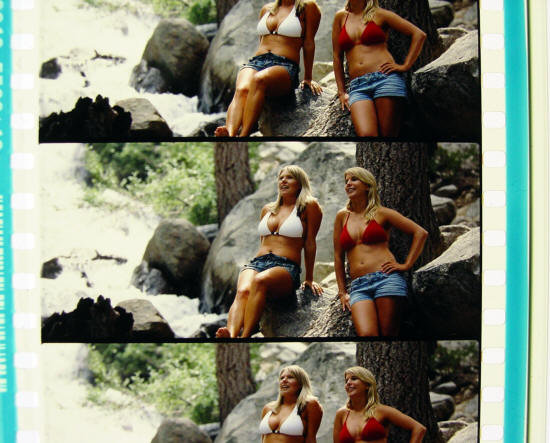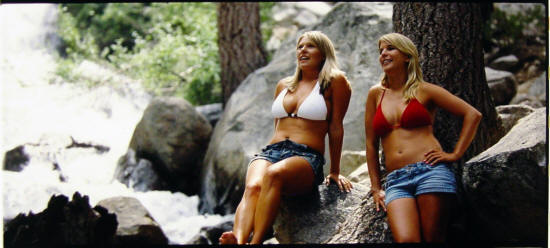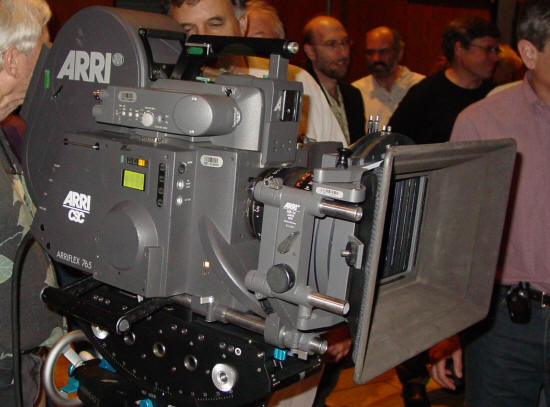"As Good as it Gets" - Afterthoughts
|
Read more
at in70mm.com The 70mm Newsletter |
| Written by: Rick Mitchell, Film Editor/ Film Director/ Film Historian. Compiled from two different articles | Date: 05.07.2007 |
 70mm
frame from the demonstration film. Katherine
Beer and Jen Johnson. Note
the colours and curves. 70mm frame blow up. 70mm
frame from the demonstration film. Katherine
Beer and Jen Johnson. Note
the colours and curves. 70mm frame blow up.There could be, if some contemporary filmmakers with true vision can be gotten to see a short test film shot last year using contemporary Eastman negative and print stocks. The project was initiated by an executive at Arri who wanted to remind film makers of what film quality could be and was shot by cinematographer Bill Bennett, ASC in Lone Pine and downtown LA under a variety of daylight and magic hour conditions. The original project involved shooting the same setups in 65mm, 35mm anamorphic, and Super 35 and a 4K DI was made of the material, a print of which was shown for comparison last November at a program called "As Good As It Gets". I missed that program but got to see the 70mm print off the original negative at a private screening at the Egyptian Theater. I had not seen new 65mm material since the Super Dimension 70 demos, and though not at 48 fps, this looked TERRIFIC!!! The detail you could see was breathtaking. Little grain was visible, and I was sitting in the seventh row. I forgot to ask if Digital Projection, even 4K, could stand up to that; some who saw the "As Good As It Gets" show, where a digital version was also shown, said that it couldn't. Mr. Bennett, who was at the screening, said that after the November program, there was a run on available 65mm cameras, as filmmakers were electing to shoot their big masters in 65mm (as was done for "The New World"), and closer angles in 35mm, usually Super 35, matching up the material in the DI. |
More
in 70mm reading: "As Good as it Gets"- Demonstrates power of large format “As Good as it Gets” - cast/credit Todd-AO Test Film Panavision and the Resurrecting of Dinosaur Technology Who is Rick Mitchell Internet link: fromscripttodvd.com Mount Vernon Visitors Center "As Good as it Gets" is available from: Henning Raedlein Head of ARRI Digital Film ARRI Film & TV Services GmbH Tuerkenstr. 89 D-80799 Muenchen Germany Phone +49 89 3809-1970 Fax +49 89 3809-1549 Email hraedlein@arri.de www.arri.de www.arricommercial.de |
 Front
view of the ARRI 765 camera. Picture by Paul Rayton Front
view of the ARRI 765 camera. Picture by Paul RaytonCould this lead to a new feature shot in 65mm? Maybe. Though the results of the survey of American 70mm equipped theaters done by New Line Cinema a couple of years ago were apparently never published, an independent survey done by fromscripttodvd.com concluded that there were still enough theaters from the Eighties to support a reasonable American 70mm release, though they aren't all the kind of venues we like to see 70mm in, and they'd all have to install DTS readers, magnetic striping apparently no longer being available, which is a print cost saving. I didn't have time to check in70mm.com to see what the situation is in Europe, but was surprised to hear that there are no 70mm screening facilities in Germany *), so the people at Arri, who do have the world's only 65mm laser scanner, have never seen this print! *) Of course, it was later learned that there are places to screen 70mm in Germany; the situation illustrates the popular mythology that seems to prevail in the exhibition world, that somehow 70mm "doesn't exist. There are at least 30 cinemas in Germany with 70mm equipment and ready to show, editor. Unfortunately, the situation with "Superman Returns" is likely to be used against any filmmaker lobbying to shoot totally in 65mm. In an American Cinematographer article, cinematographer Newton Thomas Sigel, ASC stated that after testing 65mm and being enthusiastic about the results, they elected to go with digitally shot Super 35 because the film's total release could not be in 70mm. Mr. Sigel apparently didn't do his research, or he would have known that at the height of the Eighties blowup craze, no more than 200 70mm prints were ever made, and during the roadshow era, rarely as many as fifty! But the 35mm prints, and even 16mm anamorphic, and in one instance that I know of personally, Super 8 anamorphic prints of those films are of higher quality than from 35mm photography, especially Super 35. The examples I'm citing were all photochemical reductions; I don't know what the results would be from a DI. This 70mm print was screened in Bradford, England in March, and the "As Good As It Gets" Program is to be repeated in Los Angeles prior to Cinegear. At this time, 35mm prints from a DI from a new higher resolution laser scan and a digital version will also be shown. At the moment I can't provide additional information, but will pass on any updates I hear to those who are interested. If only someone could get Clint Eastwood to that screening. |
|
"As Good As It Gets" screening at UCLA's Bridges Theater on 21 June 2007 |
|
 Katherine
Beer and Jen Johnson. Note
the colours and curves. 70mm frame blow up. Katherine
Beer and Jen Johnson. Note
the colours and curves. 70mm frame blow up.Though I saw the 70mm contact print off the 65mm negative material shot for this program a couple of months ago, I missed the original presentation last Fall, but was happy to be able to see its re-presentation at UCLA's Bridges Theater on June 21. The idea behind it was to revive interest in 65mm for origination, primarily for material that was to go through a digital intermediate. Both Bill Bennett, ASC and Kees Van Oostrum, ASC were upset at the results when footage they'd shot went through a DI and thought it might be better to originate on a larger negative. This idea actually goes back 80 years when the size of movie palaces began to greatly exceed the ability to increase the size of the screen and get acceptable images on it. Experiments were done on negatives up to 70mm and MGM and later Paramount, using 65mm, developed systems that were intended for reduction printing to 35mm. None of the Wide Film experiments caught on then, but were revived in 1953 because of and the impending CinemaScope. One effort to create a "wider screen" was the practice of masking off the old 1.37:1 frame to aspect ratios as narrow as 2:1, and projecting the results onto screens two to three times larger than in the past. This resulted in grainy, soft images and once again, originating on larger frames for reduction printing was looked into, resulting in VistaVision, and because CinemaScope also had image resolution problems, Camera 65/Ultra Panavision, CinemaScope 55, and Technirama. (This has been a very quick simplification of history, of course.) The benefits of the most recent experiments in originating on a larger frame was immediately evident in the first film screened at UCLA, "We Fight to be Free", a short film for the Mount Vernon Visitors Center in Virginia, photographed and directed by Mr. Von Oostrum. Background material, particularly vistas, were shot in 65mm, while elements to be composited with them were photographed in Super 35, often against greenscreens, using Panavision film cameras, or as digital stills. This material was scanned at 4K with the compositing done at 2K, going to a DI. The resulting 35mm anamorphic print from an IN from the DI, looked terrific, without the mushy video game look usually found in material that has been composited in a computer. There are certain shots in the film that anyone with a knowledge of the logistics of filmmaking knows had to be composited, though they don't look it, but a tape made by the effects supervisor showing how many of the composites had been done revealed a lot more prestidigitation than noticeable. The film flashes back and forward between summer and winter, and though some plates were shot in the winter, the bulk of the filming took place in the summer. The matching of simulated winter scenes into actual winter scenes is seamless. It's to be hoped that Mr. Van Oostrum will be invited to screen both the film and the behind-the-scenes, which is on video, for film classes and other interested parties. The film is being screened digitally at Mount Vernon. The original "As Good As It Gets" program was then presented, a series of shots made by Mr. Bennett in 65mm, 35mm anamorphic, and Super 35, using Arriflex cameras and Arriscope lenses for the anamorphic footage. The 65mm negative was scanned at 8K at Arriflex in Germany, the others at 4K at Fotokem in Burbank, edited and assembled into a digital intermediate. The 6 minute presentation intercut the same setups from the different formats, followed by B negative quick comparison cuts. For some reason, only two cuts from the anamorphic footage were included in the longer presentation. |
Mount Vernon Visitors Center |
 Side
view of the ARRI 765 camera. Picture by Paul Rayton Side
view of the ARRI 765 camera. Picture by Paul RaytonThree different versions of the results were presented in the recent presentation: a print from the internegative from the DI, a print made directly from the Arrilaser, and a 4K digital version using a specially installed Sony projector. It was clear that the 65mm material was always superior to the others in every way. The anamorphic footage did not look as good by comparison, plus, in shallow focus shots, the anomalies introduced by anamorphic elements were quite obvious. The Super 35 footage looked acceptable. As both hosts pointed out, the image quality difference is immediately noticeable with the 65mm on big wide shots, but things pretty much even out as you focus closer. It's hard to comment on the 4K digital version because the projector image was dimmer than the 14FL being put out by the film projectors (for 70mm, they'd be putting out 16FL.) The quality of the 65mm came through, but the other formats pretty much looked the same as in the filmouts. A clip from "The Sound of Music" was then shown on the 4K projector, from a scan of a 65mm IP, though I don't know if the type of scan rate was mentioned. It looked quite sharp, but the color appeared way oversaturated. The 70mm print of the 65mm test footage was then shown, followed by a new print of the first reel of "Baraka" (1991). This demonstration actually raises a number of questions that might be answered in a future presentation. The first is, given that the goal is higher image quality for large screen theatrical presentation, is the cost and effort worth it now that theatrical exhibition seems to really be on life support? My reference here are not to the small art houses theaters that have commanded so much serious focus over the last 15 years, but what's left of the mainstream moviegoing market, facing major attrition from the availability of downloads or DVD release the same day as theatrical release, which is increasingly likely to happen when a major studio hatches an ill-conceived $300,000,000+ turkey that they've become certain hasn't any chance of flying. As was learned during the crepe hanging of 2005, not only is the over 30 audience increasingly picky about spending the time, effort, and money to see films in theaters, but even the previously vital 15-24 set, this generation of which having grown up with increasingly larger video screens and fairly quick access to films on video, are also choosier about what they'll go to the theater. Yet few of these youngsters have seen real big screen image quality, though there is eagerness for doing so, by young and old, based on David Strohmaier's experiences showing "Cinerama Adventure" around the country, especially recently at Yale and Princeton. But is digital projection, whose results are not that different from HD in the home, really the answer? Or the degrading of superior film images through a DI? We now need to see comparisons of images wider than 1.85:1 taken through both IN/IP and DIs taken from different scan rates, (I have yet to see a 2K scan from anamorphic material that came anywhere near the image quality of an IP/IN print, duping being necessary for a fair comparison with Super 35). Examples need to be projected from both film and digital onto a really large screen, like that at the Academy's Goldwyn Theater or the Egyptian. We also need to include consideration of material originated digitally, on both high and low end equipment, since an increasing amount of that is being done today. The only real way of getting large numbers of people into theaters, especially at today's prices, is to offer them an experience in the auditorium that they can't get at home. Of course it would also be nice if what was on the screen was also worth all the effort, but there seems to be nothing technology can do to plug the intelligence gaps in the industry's executive ranks, really a pre-Katrina New Orleans. |
|
|
Go: back
- top - back issues
- news index Updated 21-01-24 |
|
